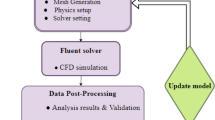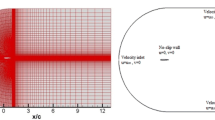Abstract
In the present study, the effect of hinge position (H) has been numerically investigated to find the appropriate position for improving the aerodynamic performance of the NACA 0012 flapped airfoil. In addition, perpendicular and tangential suctions have been applied to control the flow separation and enhance the aerodynamic performance over the NACA 0012 flapped airfoil at each different hinge positions. The simulations were carried out at a Reynolds number of 5 × 105 (Ma = 0.021) based on two-dimensional incompressible unsteady Reynolds-averaged Navier–Stokes calculations to determine the adequate hinge position. The turbulence was modeled using the shear stress transport k–ω turbulence model. The effect of perpendicular suction (θjet = − 90°) and tangential suction (θjet = − 30°) was computationally studied over NACA 0012 flapped airfoil for five different hinge positions (H = 0.7c, 0.75c, 0.8c, 0.85c and 0.9c) and a flap deflection (δf) of 15°. Based on the results, the hinge position significantly affects the aerodynamic performance of the airfoil. The lift coefficient increased clearly as the hinge position moved to the trailing edge of the airfoil. Using perpendicular suction caused to increase the lift coefficient and decrease the drag coefficient. Consequently, the maximum value of the lift-to-drag ratio (CL/CD) for perpendicular and tangential suctions was achieved about 35.8% and 25.1% higher than that of the case without suction at an angle of attack of 12° and H = 0.9c. Also, the effect of perpendicular suction was more considerable compared to the tangential suction. This caused a reduction in the size of the recirculation zone from 0.5 to 0.09 of the airfoil chord length and also transferred it from 1.13 to 1.18 of the airfoil chord length.






















Similar content being viewed by others
Abbreviations
- α :
-
Angle of attack
- β :
-
The angle between the free-stream velocity direction and the local jet surface
- c :
-
Airfoil chord length
- C P :
-
Pressure coefficient
- C L :
-
Lift coefficient
- C D :
-
Drag coefficient
- C f :
-
Skin friction coefficient
- ω (ε/k):
-
Specific dissipation rate
- k :
-
Turbulent kinetic energy
- μ :
-
Viscosity
- ρ :
-
Density
- τ :
-
Shear stress
- δ f :
-
Flap deflection
- P :
-
Pressure
- H :
-
Hinge position
- \( \rho_{\infty } \) :
-
Free-stream density
- h :
-
Hinge moment
- S f :
-
Reference area of the control surface
- C s :
-
Control surface reference chord
- q ∞ :
-
Free-stream dynamic pressure
- C h :
-
Hinge moment coefficient
- Re:
-
Reynolds number
- Ma:
-
Mach number
- U ∞ :
-
Free-stream velocity
- y + :
-
Dimensionless wall distance
- θ jet :
-
Jet angle
- L jet :
-
Jet location
- U jet :
-
Jet velocity
- R jet :
-
Jet velocity ratio
References
Obeid S, Jha R, Ahmadi G (2017) RANS simulations of aerodynamic performance of NACA 0015 flapped airfoil. Fluids 2(1):1–27
Anderson John D (2001) Fundamentals of aerodynamics. McGraw-Hill series in aeronautical and aerospace engineering, 3rd edn. McGraw-Hill, New York, pp 283–335
You D, Moin P (2008) Active control of flow separation over an airfoil using synthetic jets. J Fluids Struct 24(8):1349–1357
Günther B, Carnarius A, Thiele F (2010) Numerical investigation of active flow control applied to an airfoil with a camber flap. In: King R (ed) Active flow control II. Springer, Berlin, pp 45–61
Günther B, Thiele F, Petz R, Nitsche W, Sahner J, Weinkauf T, Hege HC (2007) Control of separation on the flap of a three-element high-lift configuration. In: 45th AIAA aerospace sciences meeting and exhibit, p 265
Prabhakar A, Ohri A (2013) CFD analysis on MAV NACA 2412 wing in high lift take-off configuration for enhanced lift generation. J Aeronaut Aerosp Eng 2:125
Amini Y, Liravi M, Izadpanah E (2018) The effects of Gurney flap on the aerodynamic performance of NACA 0012 airfoil in the rarefied gas flow. Comput Fluids 170:93–105
Xie YH, Jiang W, Lu K, Zhang D (2016) Numerical investigation into energy extraction of flapping airfoil with Gurney flaps. Energy 109:694–702
Fatahian E, Nichkoohi AL, Salarian H, Khaleghinia J (2019) Comparative study of flow separation control using suction and blowing over an airfoil with/without flap. Sādhanā 44(11):220
Mohammadi M, Taleghani AS (2014) Active flow control by dielectric barrier discharge to increase stall angle of a NACA0012 airfoil. Arab J Sci Eng 39(3):2363–2370
Cattafesta LN III, Sheplak M (2011) Actuators for active flow control. Annu Rev Fluid Mech 43:247–272
Yang L, Li J, Cai J, Wang G, Zhang Z (2016) Lift augmentation based on flap deflection with dielectric barrier discharge plasma flow control over multi-element airfoils. J Fluids Eng 138(3):031401
Svorcan JM, Fotev VG, Petrović NB, Stupar SN (2016) Two-dimensional numerical analysis of active flow control by steady blowing along foil suction side by different URANS turbulence models. Therm Sci 20(6):1–14
Hao W, Ding Q, Li C (2019) Optimal performance of adaptive flap on flow separation control. Comput Fluids 179:437–448
Shehata H, Zakaria M, Hussein A, Hajj MR (2018) Aerodynamic analysis of flapped airfoil at high angles of attack. In: 2018 AIAA aerospace sciences meeting, p 0037
Hafien C, Mbarek TB (2019) Reduced order model for the lift coefficient of an airfoil equipped with extrados and/or trailing edge flexible flaps. Comput Fluids 180:82–95
Genç MS, Kaynak Ü, Lock GD (2009) Flow over an aerofoil without and with a leading-edge slat at a transitional Reynolds number. Proc Inst Mech Eng G J Aerosp Eng 223(3):217–231
Tung C, McAlister KW, Wang CM (1993) Unsteady aerodynamic behavior of an airfoil with and without a slat. Comput Fluids 22(4–5):529–547
Yousefi K, Saleh R, Zahedi P (2014) Numerical study of blowing and suction slot geometry optimization on NACA 0012 airfoil. J Mech Sci Technol 28(4):1297–1310
Huang L, Huang PG, LeBeau RP, Hauser T (2004) Numerical study of blowing and suction control mechanism on the NACA 0012 airfoil. J Aircr 41(5):1005–1013
Fatahian H, Salarian H, Nimvari ME, Fatahian E (2018) Numerical study of suction and blowing approaches to control flow over a compressor cascade in turbulent flow regime. Int J Automot Mech Eng 15(2):1–21
Tadjfar M, Asgari E (2018) Active flow control of dynamic stall by means of continuous jet flow at Reynolds number of 1 × 106. J Fluids Eng 140(1):011107–011110
Fatahian E, Nichkoohi AL, Fatahian H (2019) Numerical study of the effect of suction at a compressible and high Reynolds number flow to control the flow separation over Naca 2415 airfoil. Prog Comput Fluid Dyn Int J 19(3):170–179
Ahmed T, Amin MT, Islam SR, Ahmed S (2014) Computational study of flow around a NACA 0012 wing flapped at different flap angles with varying Mach numbers. Glob J Res Eng 13:4–16
Genç MS, Kaynak Ü, Yapici H (2011) Performance of transition model for predicting low Re aerofoil flows without/with single and simultaneous blowing and suction. Eur J Mech B Fluids 30(2):218–235
Lei J, Liu Q, Li T (2017) Suction control of laminar separation bubble over an airfoil at low Reynolds number. Proc Inst Mech Eng G J Aerosp Eng. https://doi.org/10.1177/0954410017727025
Zhou Y, Hou L, Huang D (2017) The effects of Mach number on the flow separation control of an airfoil with a small plate near the leading edge. Comput Fluids 156:274–282
Ma D, Li G, Yang M, Wang S (2018) Research of the suction flow control on wings at low Reynolds numbers. Proc Inst Mech Eng G J Aerosp Eng 232(8):1515–1528
Fluent A (2009) 12.0 theory guide. Ansys Inc., 5(5)
Yousefi K, Saleh R (2015) Three-dimensional suction flow control and suction jet length optimization of NACA 0012 wing. Meccanica 50(6):1481–1494
Ge M, Zhang H, Wu Y, Li Y (2019) Effects of leading edge defects on aerodynamic performance of the S809 airfoil. Energy Convers Manag 195:466–479
Monir HE, Tadjfar M, Bakhtian A (2014) Tangential synthetic jets for separation control. J Fluids Struct 45:50–65
Liu D, Nishino T (2019) Unsteady RANS simulations of strong and weak 3D stall cells on a 2D pitching aerofoil. Fluids 4(1):40
Ockfen AE, Matveev KI (2009) Aerodynamic characteristics of NACA 4412 airfoil section with flap. Int J Nav Archit Ocean Eng 1(1):1–12
Yang XI, Sadique J, Mittal R, Meneveau C (2016) Exponential roughness layer and analytical model for turbulent boundary layer flow over rectangular-prism roughness elements. J Fluid Mech 789:127–165
Nichkoohi AL, Tousi AM (2014) Numerical investigation of high pressure and high Reynolds diffusion flame using Large Eddy Simulation. J Therm Sci 23(5):412–421
Shan H, Jiang L, Liu C (2005) Direct numerical simulation of flow separation around a NACA 0012 airfoil. Comput Fluids 34(9):1096–1114
Zhang W, Zhang Z, Chen Z, Tang Q (2017) Main characteristics of suction control of flow separation of an airfoil at low Reynolds numbers. Eur J Mech B Fluids 65:88–97
Menter FR (1994) Two-equation eddy-viscosity turbulence models for engineering applications. AIAA J 32(8):1598–1605
Vuddagiri A, Halder P, Samad A, Chaudhuri A (2016) Flow analysis of airfoil having different cavities on its suction surface. Prog Comput Fluid Dyn Int J 16(2):67–77
Catalano P, Amato M (2003) An evaluation of RANS turbulence modelling for aerodynamic applications. Aerosp Sci Technol 7(7):493–509
Resendiz Rosas C (2005) Numerical simulation of flow separation control by oscillatory fluid injection. Doctoral dissertation, Texas A&M University
Dannenberg RE, Weiberg JA (1952) Section characteristics of a 10.5-percent-thick airfoil with area suction as affected by chordwise distribution of permeability. NASA TN 2847
Versteeg HK, Malalasekera W (2007) An introduction to computational fluid dynamics: the finite volume method. Pearson Education, London
Farhadi A, Rad EG, Emdad H (2017) Aerodynamic multi-parameter optimization of NACA0012 airfoil using suction/blowing jet technique. Arab J Sci Eng 42(5):1727–1735
Gregory N, O’reilly CL (1973) Low-speed aerodynamic characteristics of NACA 0012 aerofoil section, including the effects of upper-surface roughness simulating hoar frost. HM Stationery Office, London
Critzos CC, Heyson HH, Boswinkle Jr RW (1955) Aerodynamic characteristics of NACA 0012 airfoil section at angles of attack from 0 deg to 180 deg (No. NACA-TN-3361). National Aeronautics and Space Administration, Washington
Jacobs EN, Sherman A (1937) Airfoil section characteristics as affected by variations of the Reynolds number. NACA report no. 586-231
Williamson G (2012) Experimental wind tunnel study of airfoils with large flap deflections at low Reynolds numbers. Master’s thesis, aerospace engineering, The University of Illinois at Urbana-Champaign, Champaign, pp 14–60
Simpson CD (2016) Control surface hinge moment prediction using computational fluid dynamics. Master dissertation, The University of Alabama
Perry III B (1978) Control-surface hinge-moment calculations for a high-aspect-ratio supercritical wing. Technical memorandum 78664, NASA
Hinze JO (1975) Turbulence. McGraw-Hill, New York
Absi R (2009) A simple eddy viscosity formulation for turbulent boundary layers near smooth walls. Comptes Rendus Mec 337(3):158–165
Hanjalić K, Launder BE (1976) Contribution towards a Reynolds-stress closure for low-Reynolds-number turbulence. J Fluid Mech 74(4):593–610
Author information
Authors and Affiliations
Corresponding author
Additional information
Technical Editor: André Cavalieri.
Publisher's Note
Springer Nature remains neutral with regard to jurisdictional claims in published maps and institutional affiliations.
Rights and permissions
About this article
Cite this article
Fatahian, E., Lohrasbi Nichkoohi, A., Salarian, H. et al. Effects of the hinge position and suction on flow separation and aerodynamic performance of the NACA 0012 airfoil. J Braz. Soc. Mech. Sci. Eng. 42, 86 (2020). https://doi.org/10.1007/s40430-020-2170-4
Received:
Accepted:
Published:
DOI: https://doi.org/10.1007/s40430-020-2170-4




